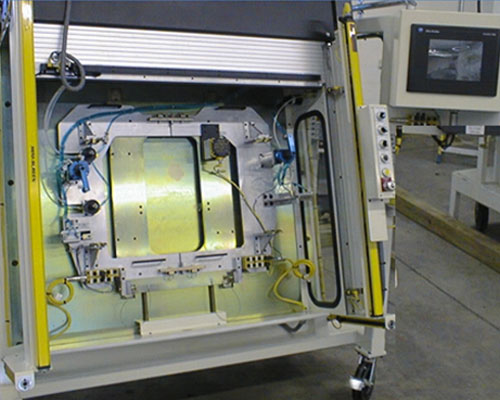Radiator Testing

Market driver:
The customer needed an inexpensive method to leak test automotive radiators. The existing process utilized helium mass spectrometry, and previous attempts to utilize pressure decay or mass flow resulted in long cycle times and poor Gage R&R (reliability and repeatability) in their production environment. The customer produces multiple designs of radiators and requires interchangeable tooling that is quick and easy to change.
Test requirement:
The radiators are presented to the test stands from an automated assembly line. Radiators are loaded/unloaded manually, but future requirements were to include robotic load/unload. The radiator header “O” rings need to be stressed prior to final leak test to check for proper seating using vacuum to simulate the stresses applied during the automotive assembly line rapid fill cycles.
The leak test specification was “no coolant leak at operating pressure”. Laboratory testing at CTS helped determined final specifications to represent an air leak of 5 scc/m @ 30 psi. The test required a 20% Gage R&R in the customer’s production environment. Some radiator designs incorporated accessory mounting clips and/or threaded inserts. The test stand required poke-yokes and sensors to confirm presence of these components. The complete test cycle including load/unload cannot exceed 60 seconds.
CTS solution:
CTS engineers reviewed previous radiator test stands and incorporated the customers’ requirements in a new design. The stands were constructed around an angled tool plate with hydraulic height adjustment on the part holder mounting position. Quick detach electrical and pneumatic manifolds were incorporated. The part holder inserts were designed using aircraft aluminum split vertically to meet a weight requirement. The test area was enclosed with an automatic roll up door to minimize the environmental effects on the part during the test cycle. A short vacuum pull down test was followed by a pressure decay leak test. Both tests were controlled by our standard Sentinel leak test instrumentation. The customer was able to save considerable cost utilizing pressure decay test stands to meet their required Gage R&R in their test cycle time. The versatility of the tooling design allowed the customer to change out their assembly line with little down time. The test stands have functioned for millions of cycles without significant maintenance. The customer has purchased multiple stands to maintain their demanding production schedule.
Contact CTS
To Discuss Your Leak Detection System Requirements
Contact CTS
Contact Cincinnati Test Systems to learn more about our leak detection equipment
Contact UsCustomer Login
An account is needed to view restricted documents such as user manuals and to submit RFQ requests.
Sign In